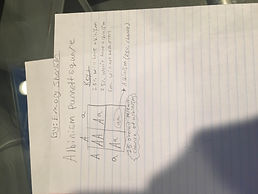Emory Jhonson - Albinism (AKA Hermansky-Pudlak Syndrome):
❏ Genotype: cc
❏ Phenotype: Albino (Very pale skin)
❏ Homozygous v. Heterozygous: Heterozygous
❏ Dominant v. Recessive: Recessive, the parent must be able to transmit the recessive allele
❏ Allele: P= pigmented allele
p= albino allele
::::::P : p
P : PP Pp
p : Pp pp
pp only appears once out of 4 times (25%)
❏ Trait: Pale skin and hair. Eyes can be the color of red. Sensitive skin. The impairment of vision.
❏ Gene: OCA2 or P gene albinism.
❏ Punnett Square:See Picture Below
❏ Pedigree:See Picture Below
❏ Inheritance Pattern:See Picture Below
❏ Explanations and examples of the following complex inheritance patterns:
❏ Polygenic Inheritance: If a parent is a carrier, their children will have a 25% chance of having Albinism. They will have pale and sensitive skin, light hair, eyebrows and eyelashes, and possibly red eyes.
❏ Incomplete Dominance: When a parent is a carrier of albinism, the way it is passed on to their children is the dominant allele is not able to dominate the recessive allele.
❏ Codominance: Albinism is a recessive gene, not codominant
❏ Multiple Alleles: Albinism exhibits Mendelian dominance, while ABO blood types are determined by multiple alleles with AB codominance. The forked-line method can be used to calculate offspring ratios of two humans who are both heterozygous for the recessive albinism allele and who are both of blood type AB.
❏ Environmental Factors: There are no environmental factors
❏ Genotypes of the following:
❏ Common Human Traits (consider the “Making Babies” Project): Pale skin, hair, eyelashes, and eyebrows, sensitive skin, red colored eyes.
❏ Blood Types (including rH factor): rH+-
❏ Common Genetic Disorders (we will look at a few in class): Impact on eye development, higher risk of skin cancer
❏ Instructions for doing the following:
❏ Determining genotypes and/or phenotypes of parents based on background information or family information (their parents and/or children): Create a pedigree and work backwards based on the children in the family that are affected by Albinism
❏ Creation of a Punnett Square using parent background information: Put the father’s alleles and place them on top of the punnett square. Take the mother’s alleles and place them on the side of the punnett square. Cross the alleles of the mother and father to then create a genotype and to see what the percentage of offspring will inherit albinism.
❏ Use of Punnett Squares to determine statistical probabilities for offspring inheriting certain traits, and to calculate genotypic/phenotypic ratios: After you combine the alleles of the mother and father, you can see by just looking at it the chance of offspring to inherit the disease. If albinism is in only one square it is a 25% chance, if it is in 2 squares it is a 50% chance and so on.
❏ Creation of a Pedigree using family history information: Find the original carrier and go on writing the genotypes of the children until the family stops.



